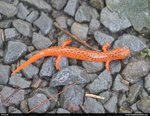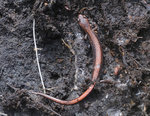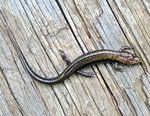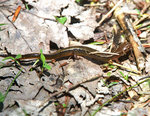 Narrowsburg
NarrowsburgLight Rain Fog/Mist, 43°
Wind: 8.1 mph
 Narrowsburg
Narrowsburg



The middle of July saw a warm spell, with temperatures getting into the 90s accompanied by high humidity that made it feel even hotter. The wildlife felt it too and hunkered down; deer spent a lot of time lying under trees or in other shady areas. My friend had his birdbath broken by a bear that leaned a little to hard on the structure while trying to drink out of it.
Cold-blooded animals, such as reptiles and amphibians, thermoregulate by moving into shade or water before they get too warm. Fish drop down into deeper water. However, there is one group of amphibians that stays in one spot and seems to remain fairly happy, as long as their habitat isn’t disturbed.
Salamanders are mostly invisible during the day, with the exception of the red-spotted newt that spends its adult life in ponds. The immature “red eft” stage of this species is very obvious in shady forests, especially in the cooler morning hours. Other species of salamanders seem to be absent, but they are nearby. During the day, many species of salamanders stay out-of-sight under rocks and logs. Such hiding places are their daytime refuge, and some species lay their eggs in these spots. At night, many of these salamanders come out to forage for small insects. In certain areas during the spring, you may spot them in numbers when they emerge and migrate to their breeding grounds.
Comments
No comments on this item Please log in to comment by clicking here